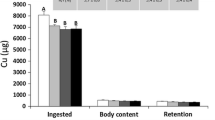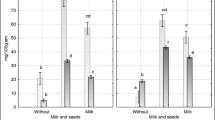Abstract
The bioavailability and interactive effects of calcium, iron and zinc fortified whole wheat flour chapattis on female Sprague–Dawley albino rats were determined. The whole wheat flour was fortified with CaCO3, FeSO4 and ZnSO4 at 1000, 40 and 20 mg/kg, respectively and fed to 64 female Sprague–Dawley rats for 4 weeks. Retention of Ca, Fe and Zn was determined in plasma, femur and liver tissues. Ca levels in plasma and liver did not alter significantly while the Ca retention in femur changed significantly with the change in fortificants. The calcium retention was higher in the femur of rats fed on the diet supplemented with Ca + Zn (221 ± 13.61 mg/g) than the rats fed on the diet supplemented with Ca + Fe (219 ± 18.92 mg/g). The iron in plasma, liver and femur ranged from 2.19 ± 0.11 to 2.77 ± 0.10 μg/ml, 203.5 ± 13.24 to 251.5 ± 17.19 μg/g and 43.5 ± 1.05 to 52 ± 2.07 μg/g while zinc content ranged from 1.31 ± 0.089 to 1.55 ± 0.114 μg/ml, 89.5 ± 3.41 to 132 ± 6.10 μg/g and 175 ± 8.29 to 191 ± 10.85 μg/g, respectively. The minerals interacted with each other resulting in decrease of bioavailability among each other. The absorption was higher in the rats fed on fortified diet than those fed on unfortified chapatti diet. Hence, it is concluded that fortification of whole wheat flour is feasible to overcome the Ca, Fe and Zn malnutrition in the vulnerable groups.
Similar content being viewed by others
References
Meschino J (2002) Calcium: requirements, bioavailable forms, physiology and clinical aspects. Dyn Chiropr 20:18
Vallee BL, Falchuk KH (1993) The biochemical basis of zinc physiology. Physio Rev 73:79–118
Ross J, Horton S (1998) Economic consequences of iron deficiency. Ottawa, Micronutrient Initiative. International Agriculture Centre, Wageningen, Netherlands
Heaney RP (2000) Calcium, dairy products and osteoporosis. J Am Coll Nutr 19:83S–99S
NNS (2002) National Nutrition Survey. Planning Commission. Islamabad. Government of Pakistan
Darnton-Hill I (1998) Overview: rationale and elements of a successful food-fortification programme. Food Nutr Bull 19:92–100
Gibson RS, Donovan UM, Heath ALM (1997) Dietary strategies to improve the iron and zinc nutriture of young women following a vegetarian diet. Plant Foods Hum Nutr 51:1–16
Lotfi M, Mannar MGV, Merx RHJ, Naber-van den M, Heuvel P (1996) Micronutrient fortification of foods: Current practices, research and opportunities. Ottawa. The Micronutrient Initiative, International Agriculture Centre, Wageningen, Netherlands
Whittaker P (1998) Iron and zinc interactions in humans. Am J Clin Nutr 68:442–446
Ames SK, Gorham BM, Abrams SA (1999) Effects of high compared with low calcium intake on calcium absorption and incorporation of iron by red blood cells in small children. Am J Clin Nutr 70:44–48
Sandstead HH (2000) Causes of iron and zinc deficiencies and their effects on brain. J Nutr 130:347–349
Bendich A (2001) Calcium supplementation and iron status of females. Nutrition 17:46–51
Rehman SU, Anjum SA, Anjum FM (2006) Storage stability of ferrous iron in whole wheat flour naan production. J Food Proc Pres 30:323–334
Levrat-Verny MA, Coudray C, Bellanger J, Lopez HW, Demigne C, Rayssiguier Y, Remesy C (1999) Wholewheat flour ensures higher mineral absorption and bioavailability than white wheat flour in rats. Br J Nutr 82:17–21
AACC Approved methods of American Association of Cereal Chemists. American Association of Cereal Chemists, Inc., St. Paul, Minnesota
Haug W, Lantszch HJ (1983) Sensitive method for the rapid determination of phytate in cereals and cereal products. J Sci Food Agric 34:1423–1426
Gueguen L, Pointillart A (2000) The bioavailability of dietary calcium. J Am Coll Nutr 19:119S–136S
Hoek AC, Lemmens AG, Mullinik JWMA, Beynen AC (1988) Influence of dietary calcium: phosphorus ratio on mineral excretion and nephrocalcinosis in female rats. J Nutr 118:1210–1216
Sandstrom B (2001) Micronutrient interactions, effects on absorption and bioavailability. Br J Nutr 85:181–185
Herman S, Griffin IJ, Suwarti S, Ernawati F, Permaesih D, Pambudi D, Abrams SA (2002) Cofortification of iron-fortified flour with zinc sulfate, but not zinc oxide, decreases iron absorption in Indonesian children. Am J Clin Nutr 76:813–817
Windisch W, Kirchgessner M (1999) Zinc absorption and excretion in adult rats at zinc deficiency induced by dietary phytate additions: I. Quantitative zinc metabolism of Zn65 labelled adult rats at zinc deficiency. J Animal Physiol 82:106–115
Lonnerdal B (2000) Dietary factors influencing zinc absorption. J Nutr 130:1378S–1383S
Dendougui F, Schwedt G (2004) In vitro analysis of binding capacities of calcium to phytic acid in different food samples. Eur Food Res Technol 219:409–415
Grewal HK, Hira CK (2003) Effect of processing and cooking on zinc availability from wheat (Triticum aestivum). Plant Foods Hum Nutr 58:1–8
Uthus EO, Zaslavsky B (2001) Interaction between zinc and iron in rats. Bio Trace Elem Res 82:167–183
Author information
Authors and Affiliations
Corresponding author
Rights and permissions
About this article
Cite this article
Ahmed, A., Anjum, F.M., Ur Rehman, S. et al. Bioavailability of Calcium, Iron and Zinc Fortified Whole Wheat Flour Chapatti. Plant Foods Hum Nutr 63, 7–13 (2008). https://doi.org/10.1007/s11130-007-0062-8
Received:
Accepted:
Published:
Issue Date:
DOI: https://doi.org/10.1007/s11130-007-0062-8




